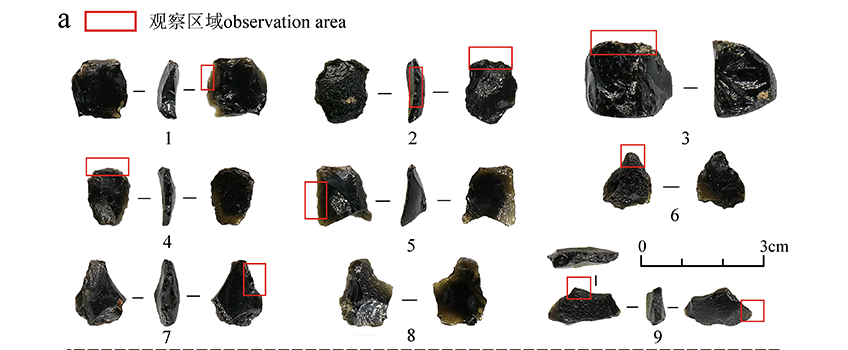

Research on the tektite artifacts unearthed at the Yahuai Cave site in Guangxi
Received date: 2024-10-18
Revised date: 2025-05-14
Online published: 2025-06-18
Tektites are frequently discovered in prehistoric sites in Guangxi, yet research on the associated artifacts remains limited. This study conducts an in-depth archaeological analysis of the tektite artifacts unearthed at the Yahuai Cave site in Guangxi, exploring their role and significance in the lives of ancient humans. These tektite specimens originate from the Australasian strewn field and exhibit identical provenance to those tektites recovered from sedimentary strata within Baise Basin, Guangxi. Their formation correlates with the Australasian tektite event, dating to approximately 700,000~800,000 years before present. A comprehensive approach we employed that includes methods such as technological analysis, statistical analysis, energy dispersive X-ray spectroscopy (EDXRF) analysis,and use-wear analysis to investigate the physical and chemical characteristics, flaking strategies, retouch logic, post-depositional modification, and usage conditions of the tektite assemblages.
The results of EDXRF analysis demenstrate that the tektites from the Yahuai Cave site are chemically consistent with those from surrounding areas. Regarding to the tool manufacturing, two flaking strategies were employed: the bipolar knapping and the "strike-rotate" knapping. Additionally, comprehensive and meticulous or localized retouched methods were adopted based on actual needs, demonstrating a profound understanding and adaptation to the material properties. It also reveals the optimization and improvement in stone tool manufacturing by ancient people. The evaluation of post-depositional modification indicates that the tektites experienced a certain degree of wear during the post-depositional process, but it did not significantly affect the use-wear traces of their surfaces.
The analysis of usage logic suggests that the use of tektites at the Yahuai Cave site was primarily related to the development and exploitation of animal resources, possibly closely associated with hunting and butchering activities. These findings not only provide new insights into the trend of miniaturization of stone artifacts in southern regions but also offer valuable information for understanding how ancient humans adapted to environmental changes, utilized resources, and the evolution of social structures.
Overall, this article discusses the uniqueness of these tektites and their prevalence in the Yahuai Cave site, highlighting their important role in ancient toolkits. The results suggests that the utilization of tektites reflects the ability of ancient humans to adapt to their environment and make economic strategy choices. Furthermore, it provides a new perspective and evidence for exploring both the trend of stone artifacts miniaturization in southern China and the dispersal routes of modern humans.

Key words: tektite artifacts; use-wear analysis; Yahuai Cave site; stone tools
GUO Yunhao , CHEN Hong , LI Dawei , XIE Guangmao , XUE Liping . Research on the tektite artifacts unearthed at the Yahuai Cave site in Guangxi[J]. Acta Anthropologica Sinica, 2025 , 44(03) : 451 -465 . DOI: 10.16359/j.1000-3193/AAS.2025.0049
| [1] | 陈宏毅, 樊聪. 天外来客还是地球自生?——“玻璃陨石”成因谜团详解[J]. 地球, 2022, 5: 60-65 |
| [2] | 何贤伟, 张林. 雷公墨称谓创立作者及其年代辨析[J]. 中国矿业, 2023, 32(S2): 128-131 |
| [3] | 潘卿, 肖智勇. 华南地区澳大利亚-亚洲远撞击溅射玻璃的磁学性质研究[J]. 地球科学, 2024, 49(8): 2766-2788 |
| [4] | Hou YM. Mid-Pleistocene Acheulean-like Stone Technology of the Bose Basin, South China[J]. Science, 2000, 287(5458): 1622-1626 |
| [5] | 王頠, 莫进尤, 黄志涛. 广西百色盆地大梅南半山遗址发现与玻璃陨石共生的手斧[J]. 科学通报, 2006, 18: 2161-2165 |
| [6] | 朱照宇, 周厚云, 乔玉楼, 等. 华南玻璃陨石的原生层位及其事件地层学意义[J]. 地质力学学报, 2001, 4: 296-302 |
| [7] | 王幼平. 砾石工业传统与华南旧石器晚期文化[J]. 南方文物, 2021, 1: 91-97 |
| [8] | 卢杰英. 隆安娅怀洞遗址保护与利用探讨[J]. 广西民族师范学院学报, 2021, 38(4): 13-18 |
| [9] | 谢光茂, 余明辉, 卢杰英. 广西隆安娅怀洞遗址发掘报告[J]. 人类学学报, 2025, 44(3): 365-388 |
| [10] | 赵文丫. 广西隆安娅怀洞遗址动物遗存鉴定及分析[D]. 硕士研究生毕业论文, 济南: 山东大学, 2018 |
| [11] | 宋艳波, 谢光茂, 赵文丫. 广西隆安娅怀洞遗址出土动物遗存初步研究[J]. 第四纪研究, 2020, 40(2): 344-346+348-353 |
| [12] | Wu Y, Xie GM, Mao LM, et al. Phytolith evidence for human-plant subsistence in Yahuai Cave (Guangxi, South China) over the past 30000 years[J]. Science China Earth Sciences, 2020, 11: 1745-1757 |
| [13] | 王小庆. 石器使用痕迹显微观察的研究[M]. 北京: 文物出版社, 2008 |
| [14] | 陈虹. 鉴微寻踪:旧石器时代石英岩石制品的微痕与功能研究[M]. 杭州: 浙江大学出版社, 2020 |
| [15] | Keeley LH. Experimental determination of stone tool uses: a microwear analysis[M]. Chicago: University of Chicago Press, 1980 |
| [16] | 黄志涛, 张成江. 广西玻璃陨石的微量元素地球化学特征[J]. 矿物岩石, 2002, 1: 46-48 |
| [17] | 李颖, 周振宇, 杨益民, 等. 广西邕宁顶蛳山遗址出土黑色石料材质的光谱无损分析[J]. 光谱学与光谱分析, 2022, 42(1): 253-257 |
| [18] | 黄志涛, 张成江. 广西玻璃陨石的微量元素地球化学特征[J]. 矿物岩石, 2002, 1: 46-48 |
| [19] | 陕西省考古研究所, 大荔县文管会.陕西大荔县发现的早期旧石器文化遗存[J]. 考古与文物, 1994, 1: 1-20 |
| [20] | 张森水, 周春茂. 大荔人化石地点第二次发掘简报[J]. 人类学学报, 1984, 3(1): 19-29 |
| [21] | Whittaker JC. Flintknapping: making and understanding stone tools[M]. Austin: University of Texas Press, 1994 |
| [22] | 杨霞, 陈虹. 石制品后埋藏微痕的实验研究述评[J]. 东南文化, 2017, 3: 20-26 |
| [23] | 刘吉颖. 浙江紫金山遗址燧石制品的功能研究[D]. 硕士研究生毕业论文, 杭州: 浙江大学, 2017 |
| [24] | Chen H, Wang J, Lian HR, et al. An experimental case of bone-working use wear on quartzite artifacts[J]. Quaternary International, 2015, 434(A): 129-137 |
| [25] | Liu JY, Chen H. An experimental case of wood-working use-wear on quartzite artefacts[J]. Documenta Praehistorica, 2016, 43: 507 |
| [26] | 王幼平. 现代人扩散南线的考古学观察[J]. 南方文物, 2023, 3: 147-156 |
| [27] | 王幼平. 南方晚更新世晚期人类行为复杂化的个案——江西万年吊桶环遗址的发现[J]. 人类学学报, 2016, 35(3): 397-406 |
| [28] | 周玉端. 柳州白莲洞遗址石器工业的技术分析[D]. 硕士研究生毕业论文, 武汉: 武汉大学, 2017 |
| [29] | 程立文. 岭南地区旧石器时代晚期至新石器时代打制石器初步研究[D]. 硕士研究生毕业论文, 南宁: 广西师范大学, 2019 |
| [30] | 刘文. 柳州白莲洞、鲤鱼嘴遗址燧石石器[J]. 四川文物, 2008, 6: 36-38 |
| [31] | 王幼平. 砾石工业传统与华南旧石器晚期文化[J]. 南方文物, 2021, 1: 91-97 |
| [32] | 傅宪国, 李新伟, 李珍, 等. 广西邕宁县顶蛳山遗址的发掘[J]. 考古, 1998, 11: 11-33 |
| [33] | 陈虹, 孙明利, 唐锦琼. 苏州五峰北遗址磨制石器的“操作链”及“生命史”研究[J]. 考古, 2020, 11: 72-82 |
/
| 〈 |
|
〉 |